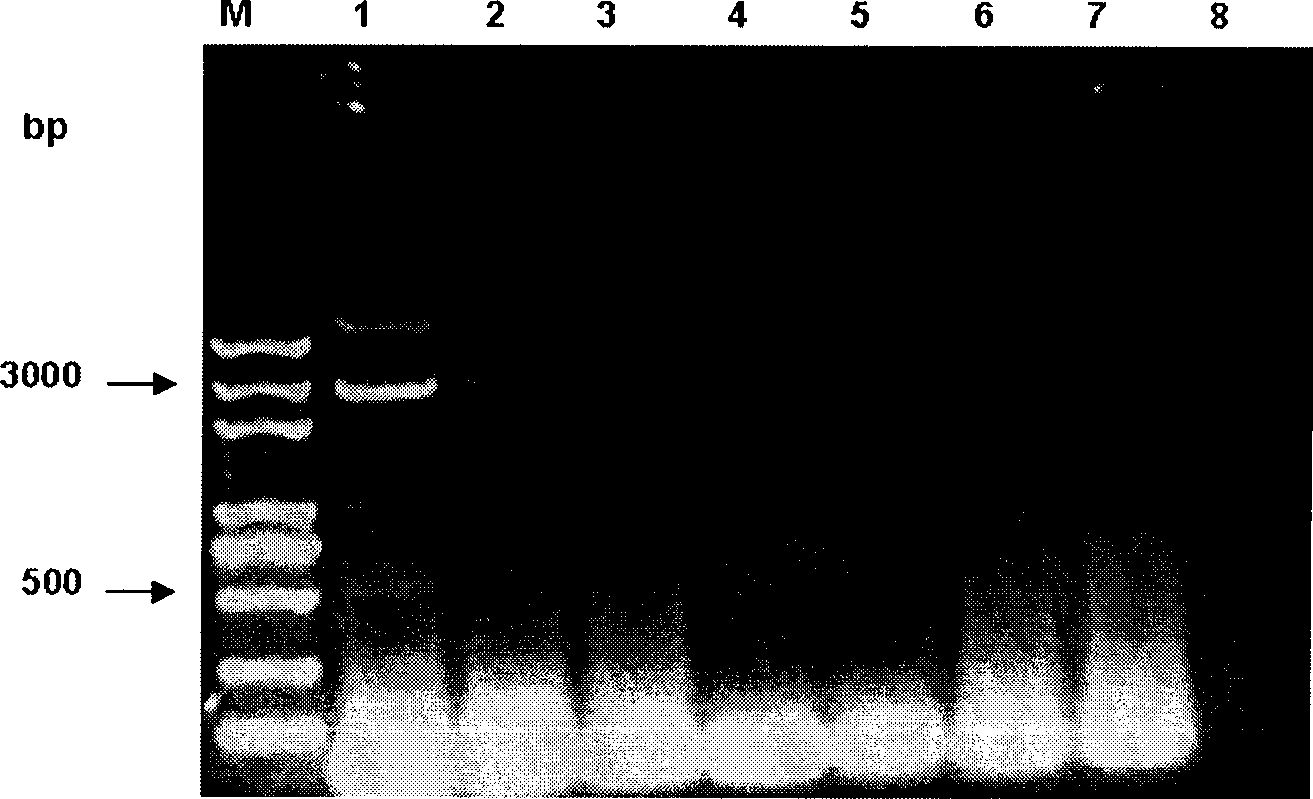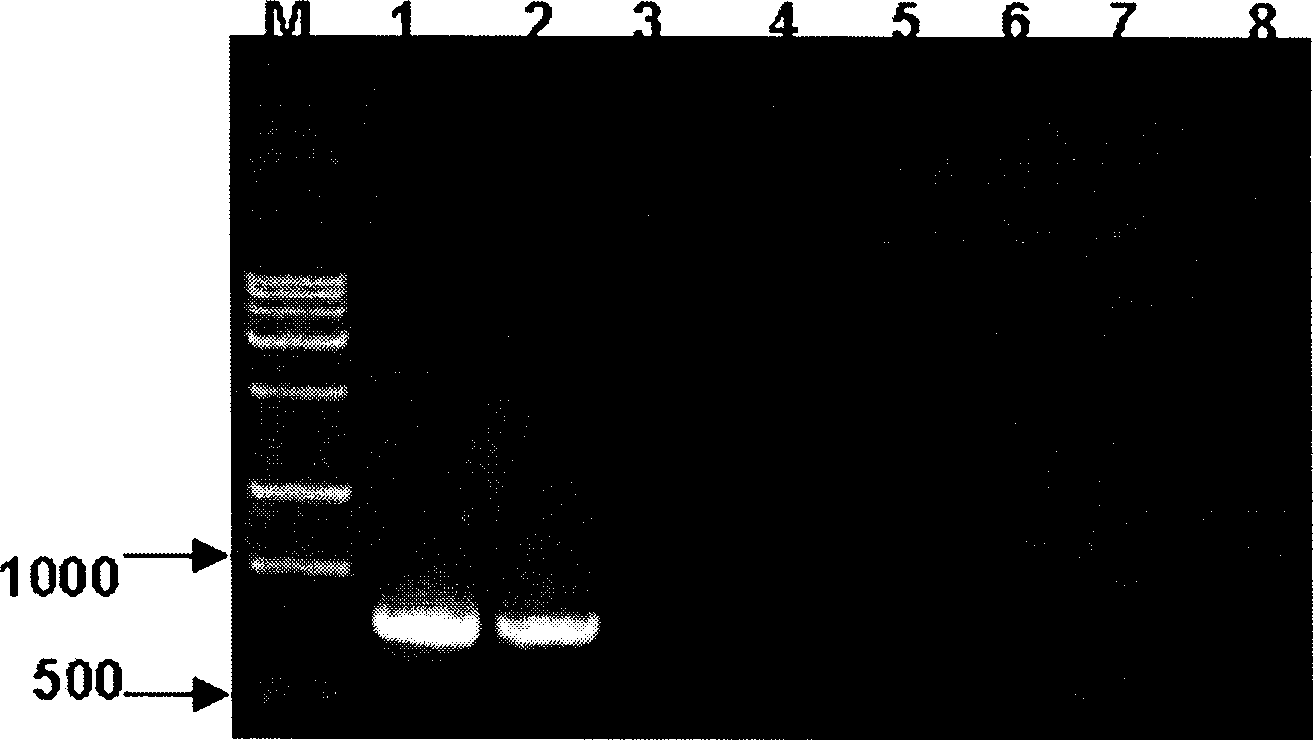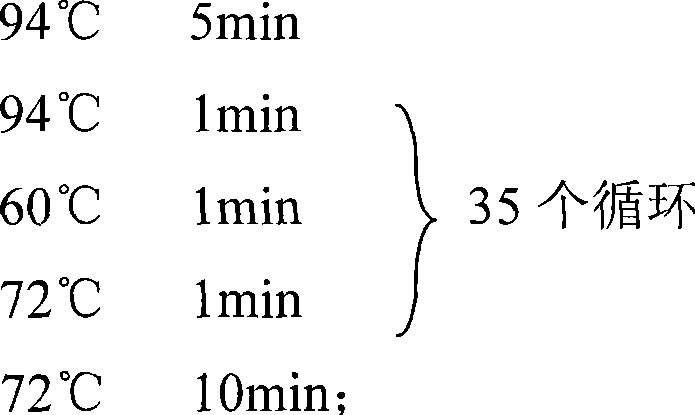Method for detecting chrysanthemum B virus
A chrysanthemum and virus technology, applied in biochemical equipment and methods, microbial determination/inspection, etc., can solve the problems of easy cross-contamination, high detection cost, complicated operation, etc., and achieve the effect of high specificity and easy identification.
- Summary
- Abstract
- Description
- Claims
- Application Information
AI Technical Summary
Problems solved by technology
Method used
Image
Examples
Embodiment 1
[0026] A method for detecting chrysanthemum B virus, which uses loop-mediated isothermal amplification reaction (LAMP) to detect chrysanthemum B virus.
[0027] The steps included in the method are as follows:
[0028] A. Prepare the reaction system in the Eppendoff tube of 1.5-2.0ml; The solvent used is redistilled water (ddH 2 O);
[0029] B. Incubate the reaction system to obtain an incubation product; the temperature of the incubation treatment is 65°C, and the time is 30-80min, preferably 60min; the incubation treatment is carried out in a metal constant temperature mixer ;
[0030] C. The incubation product is subjected to inactivation treatment to obtain a reaction product; the temperature of the inactivation treatment is 80° C., and the time is 5-15 minutes, preferably 10 minutes; the inactivation treatment is carried out in a metal constant temperature mixer It can also be carried out in a water bath or a metal bath;
[0031] D. detecting the reaction product and ...
Embodiment 2
[0038] This example is the composition of the reaction system described in Example 1. Include in this reaction system:
[0039] Betaine 0.6-1.4mol / L,
[0040] dNTP 0.25-2.5mmol / L,
[0041] Mg 2+ 2-12mmol / L,
[0042] Outer primers, inner primers; the concentration ratio of the inner primers and outer primers is 1:1-1:8;
[0043] Introduce Mg in this embodiment 2+ The method is: adding concentration is the MgCl of 2-12mmol / L in this reaction system;
[0044]The amount of the inner primer is 0.2 μmol / L, and the amount of the outer primer is 0.8 μmol / L; taking the system with a volume of 25 μl as an example, the system also includes: 1U Bst DNA polymerase large fragment 1 μl, 10×Bst Polymerse buffer 1μl, DNA template (21μg / ml concentration) 1μl, sufficient ddH 2 O;
[0045] The volume of the reaction system may also be 50 μl.
[0046] The DNA template is extracted from a chrysanthemum plant infected with B virus, and the preparation method of the DNA template is...
Embodiment 3
[0057] This example is a preferred scheme based on Example 2, and the quality and source of each component in the reaction system used are the same as those in Example 2. Include in this reaction system:
[0058] Betaine 0.6mol / L,
[0059] dNTP 0.4mmol / L,
[0060] Mg 2+ 2mmol / L,
[0061] Outer primers, inner primers; the concentration ratio of the inner primers and outer primers is 1:1;
[0062] Introduce Mg in this embodiment 2+ The method is: in this reaction system, adding concentration is the MgCl of 2mmol / L;
[0063] The amount of the inner primer is 0.2 μmol / L, and the amount of the inner primer is 0.2 μmol / L. Taking the system with a volume of 25 μl as an example, the system also includes: 1U Bst DNA polymerase large fragment 1 μl, 10×Bst Polymerse buffer 1μl, DNA template (21μg / ml concentration) 1μl, sufficient ddH 2 O;
[0064] The volume of the reaction system may also be 50 μl.
[0065] The primers and their sources used in this example are the sa...
PUM
 Login to View More
Login to View More Abstract
Description
Claims
Application Information
 Login to View More
Login to View More - R&D
- Intellectual Property
- Life Sciences
- Materials
- Tech Scout
- Unparalleled Data Quality
- Higher Quality Content
- 60% Fewer Hallucinations
Browse by: Latest US Patents, China's latest patents, Technical Efficacy Thesaurus, Application Domain, Technology Topic, Popular Technical Reports.
© 2025 PatSnap. All rights reserved.Legal|Privacy policy|Modern Slavery Act Transparency Statement|Sitemap|About US| Contact US: help@patsnap.com



